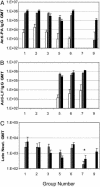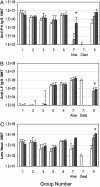A cationic lipid-formulated plasmid DNA vaccine confers sustained antibody-mediated protection against aerosolized anthrax spores
- PMID: 15342913
- PMCID: PMC518760
- DOI: 10.1073/pnas.0405557101
A cationic lipid-formulated plasmid DNA vaccine confers sustained antibody-mediated protection against aerosolized anthrax spores
Abstract
DNA vaccines provide an attractive technology platform against bioterrorism agents due to their safety record in humans and ease of construction, testing, and manufacture. We have designed monovalent and bivalent anthrax plasmid DNA (pDNA) vaccines encoding genetically detoxified protective antigen (PA) and lethal factor (LF) proteins and tested their immunogenicity and ability to protect rabbits from an aerosolized inhalation spore challenge. Immune responses after two or three injections of cationic lipid-formulated PA, PA plus LF, or LF pDNAs were at least equivalent to two doses of anthrax vaccine adsorbed (AVA). High titers of anti-PA, anti-LF, and neutralizing antibody to lethal toxin (Letx) were achieved in all rabbits. Eight or nine animals in each group were challenged with 100x LD(50) of aerosolized anthrax spores 5 or 9 weeks after vaccination. An additional 10 animals vaccinated with PA pDNA were challenged >7 months postvaccination. All animals receiving PA or PA plus LF pDNA vaccines were protected. In addition, 5 of 9 animals receiving LF pDNA survived, and the time to death was significantly delayed in the others. Groups receiving three immunizations with PA or PA plus LF pDNA showed no increase in anti-PA, anti-LF, or Letx neutralizing antibody titers postchallenge, suggesting little or no spore germination. In contrast, titer increases were seen in AVA animals, and in surviving animals vaccinated with LF pDNA alone. Preclinical evaluation of this cationic lipid-formulated bivalent PA and LF vaccine is complete, and the vaccine has received U.S. Food and Drug Administration Investigational New Drug allowance.
Figures



References
-
- Joellenbeck, L., Zwanziger, L. L., Durch, J. S. & Strom, B. L., eds. (2002) The Anthrax Vaccine: Is It Safe? Does It Work? (Natl. Acad. Press, Washington, DC). - PubMed
-
- Dixon, T. C., Meselson, M., Guillemin, J. & Hanna, P. C. (1999) N. Engl. J. Med. 341, 815–826. - PubMed
-
- Mock, M. & Mignot, T. (2003) Cell Microbiol. 5, 15–23. - PubMed
-
- Bradley, K. A., Mogridge, J., Mourez, M., Collier, R. J. & Young, J. A. (2001) Nature 414, 225–229. - PubMed
Publication types
MeSH terms
Substances
Associated data
- Actions
- Actions
- Actions
Grants and funding
LinkOut - more resources
Full Text Sources
Other Literature Sources
Medical
Research Materials

